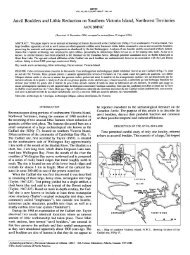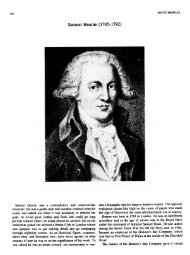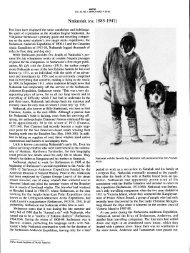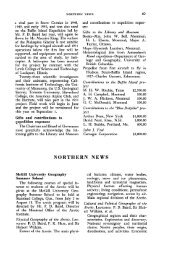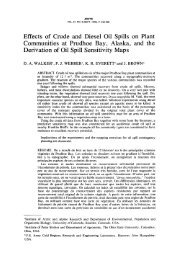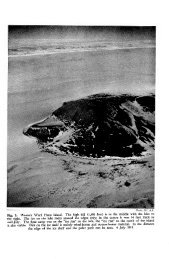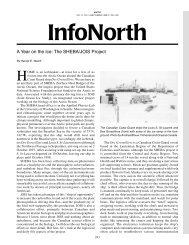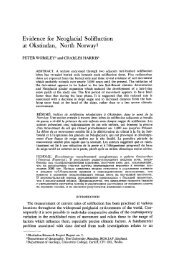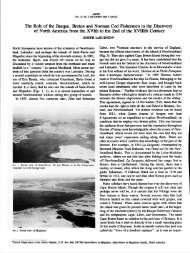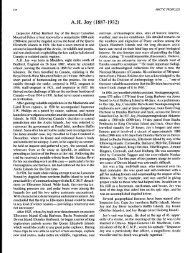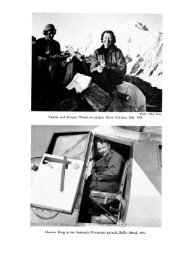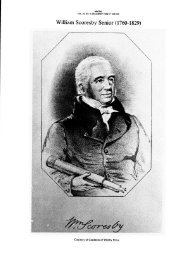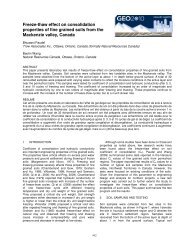NOTES ON THE NUNAMIUT ESKIMO AND MAMMALS OF ... - arctic
NOTES ON THE NUNAMIUT ESKIMO AND MAMMALS OF ... - arctic
NOTES ON THE NUNAMIUT ESKIMO AND MAMMALS OF ... - arctic
Create successful ePaper yourself
Turn your PDF publications into a flip-book with our unique Google optimized e-Paper software.
102 ’SHE NUNARTIUT <strong>ESKIMO</strong> <strong>AND</strong> MAhlMALS <strong>OF</strong> <strong>THE</strong> ANAKTUVUK PASS RF,GI<strong>ON</strong><br />
snare was placed at a distance above the ground equal to the height of a man’s<br />
knee plus the width of the hand with thumb extended, and the loop itself was<br />
large enough to enclose the antlers of a large bull. The corral, or kangigak,<br />
was constructed along a river where a low ridge prevented the caribou seeing<br />
it until too late for them to turn back, and was used year after year. It<br />
consisted of an enclosure of rocks and willow branches. The side walls were<br />
single, but the far end consisted of rows of alternate walls and openings in<br />
which the snares were set. Piles of sod diverged from the corral mouth for<br />
several miles, and the animals were driven by runners, called tovoksiroak. The<br />
people were careful to stay away from the front of the corral, or the caribou<br />
might detect the human scent. Once the caribou had forded the stream, they<br />
would not ordinarily return. Blinds were prepared at the mouth of the<br />
corral, and men waited in these while the drivers forced the animals over the<br />
ridge at high speed, into the mouth of the corral. The men then rushed from<br />
the blinds to close the entrance, shooting at the milling animals with the bow.<br />
Ailany were killed by arrows while those trying to escape through the openings<br />
of the back walls were snared.<br />
The kangigak was last used about seventy-five years ago, when the parents<br />
of the men now living were young. The remains of an old corral are still<br />
visible near Tulugak Creek, just north of Tulugak Lake, and others are<br />
found on the Killik River and near Chandler Lake, such as the one at Okominilaga.<br />
Stefansson (1914, p. 385) gives a diagram of a corral similar to this, the<br />
details of which he got from a Tigiragmiut man.<br />
The importance of the caribou to the Nunamiut is very evident. It is not<br />
surprising that three of their “moons” of the year are named for something to<br />
do with caribou. Thus, June is called E1*iknzivik (“fawning time”); September,<br />
Amigaiksivik (“time velvet is lost from antlers”); and October is called<br />
Nuliakvik (“time of rut”).<br />
Through their long dependence upon the caribou, the Nunamiut have<br />
gained a thorough understanding of its habits. These men would be of great<br />
aid as observers in any intensive study of caribou, since there is probably no<br />
white man living who knows the animal as well.<br />
The Nunamiut names for animals of the various ages are as follows:<br />
Nogak-calf.<br />
Angayukliakruk-yearling 8.<br />
Nukatagak-young 8 .<br />
Nukatagakruk-3-year-old 8 .<br />
Puknikruak-4-year-old 8 .<br />
Puknik-bull, 5 years and older.<br />
Kulavak-cow.<br />
Five skulls, from near Tulugak<br />
National Museum.<br />
Lake, have been deposited in the US.<br />
Ovibos moschatus ?moschatus (Zimmermann) . Umikmk (umik, “beard”;<br />
-rnuk, variant of -puk or -vuk, “big”). Muskox.<br />
During the spring of 1951 Mr. John Krog, of the Arctic Health Research<br />
Center, picked up a badly-weathered muskox skull while making ornithological



